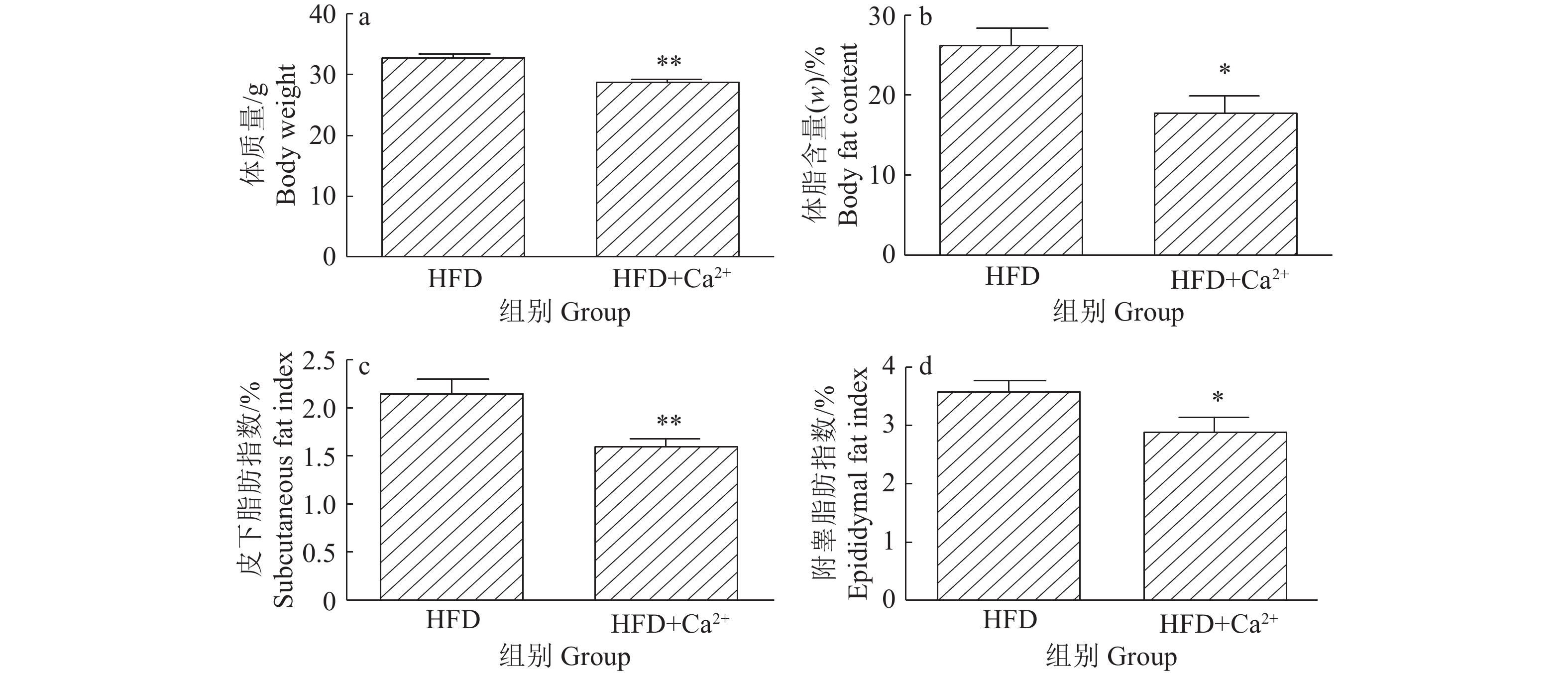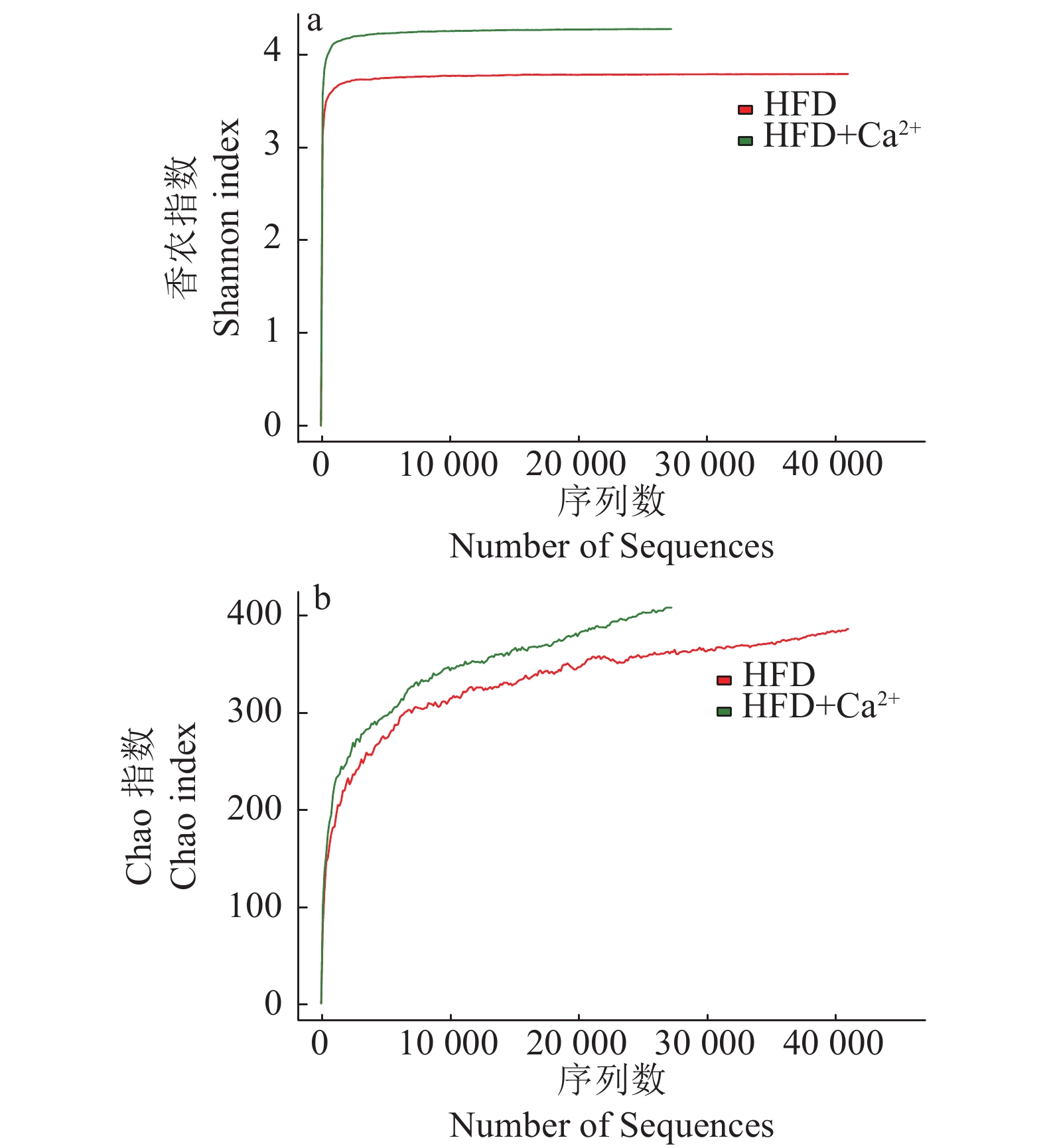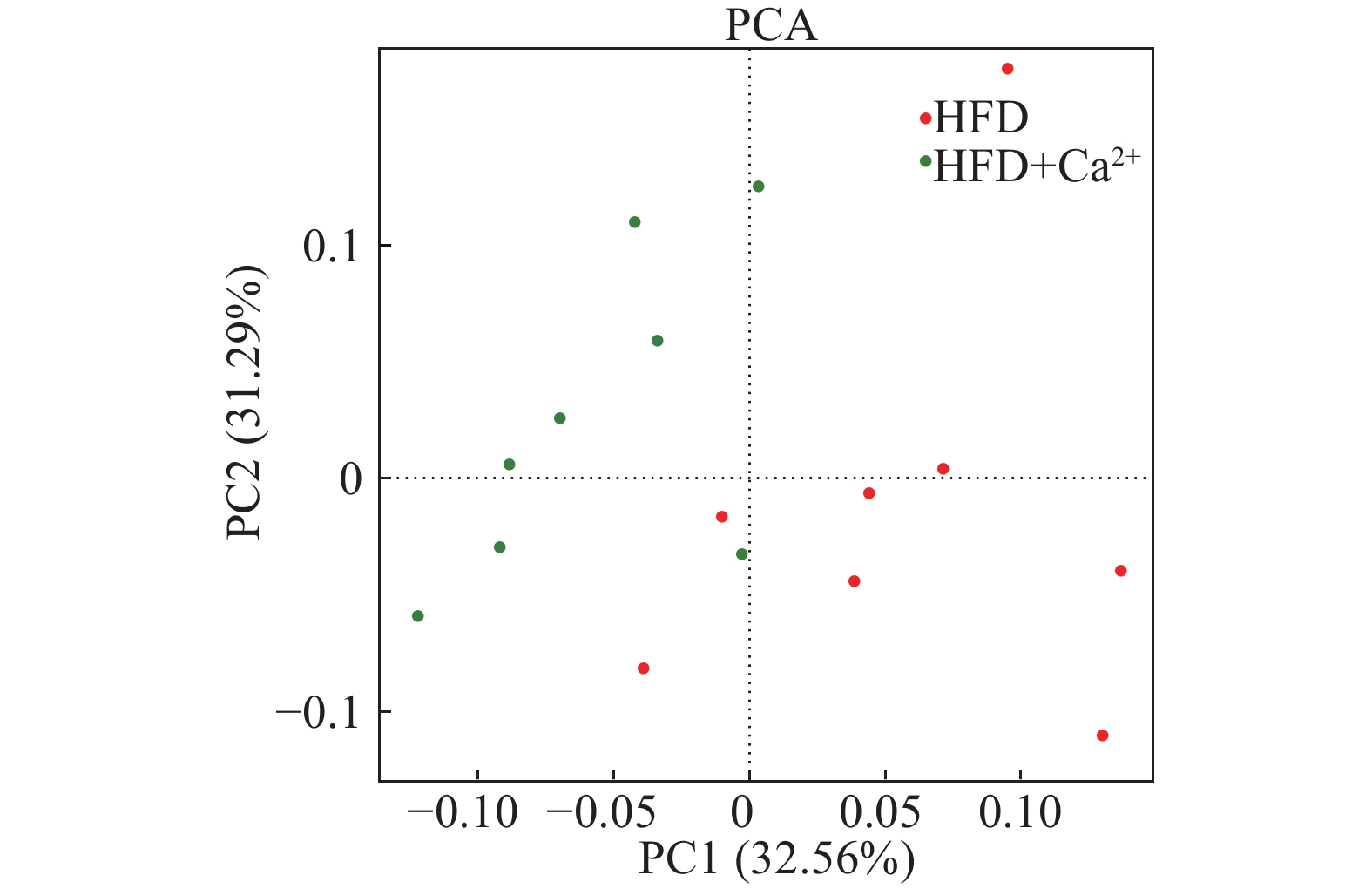Effects of calcium chloride supplementation in drinking water on fat deposition and intestinal flora in mice fed with high-fat diet
-
摘要:目的
研究饮水添加氯化钙对高脂日粮饲喂小鼠脂肪沉积和肠道菌群的影响,为提高动物胴体品质和人体健康提供理论依据。
方法选用27只4周龄C57BL雄性小鼠,分为高脂日粮组和高脂日粮+饮水添加氯化钙组,试验期13周。每周测定小鼠体质量,试验末测定小鼠体脂含量,试验结束后采集小鼠皮下脂肪、附睾脂肪并称质量。于试验后期10~12周采集小鼠粪便进行16S rRNA高通量测序,并分析对菌群的影响。
结果饮水添加氯化钙显著降低了小鼠体质量、体脂含量、皮下脂肪指数和附睾脂肪指数,与高脂组相比分别降低了12.85%、32.69%、26.65%和18.60%。饮水添加氯化钙提高了小鼠粪便样中的菌群多样性和菌群丰度。在门水平下,饮水添加氯化钙对拟杆菌门Bacteroidetes、厚壁菌门Firmicutes、变形菌门Proteobacteria、脱铁杆菌门Deferribacteres、放线菌门Actinobacteria、软壁菌门Tenericutes的丰度无明显影响。在纲水平下,与高脂组相比,饮水添加氯化钙显著降低了丹毒丝菌纲Erysipelotrichia和放线菌纲Actinobacteria的相对丰度,并且显著提高了梭菌纲Clostridia的相对丰度。
结论饮水添加氯化钙能够降低高脂日粮饲喂小鼠的体质量和体脂含量,这可能与饮水添加氯化钙提高了小鼠粪便菌群多样性和特定菌群丰度有关。
Abstract:ObjectiveTo investigate the effects of calcium chloride supplementation in drinking water on fat deposition and intestinal flora in mice fed high-fat diet, and provide a theoretical basis for improving carcass characteristics of animals and human health.
MethodTwenty-seven 4-week-old C57BL male mice were divided into two groups including a high-fat diet (HFD) group and a group with HFD+calcium chloride supplementation in drinking water. The experiment was conducted for 13 weeks. The body weight of mouse was measured weekly. The body fat content of mouse was determined at the end of the experiment. After mice were sacrificed, the subcutaneous fat and epididymal fat of mice were collected and weighed. Mouse feces were collected during 10−12 weeks for high-throughput sequencing of 16S rRNA and the effects on intestinal flora were analyzed.
ResultCalcium chloride supplementation in drinking water significantly reduced the body weight, body fat content, subcutaneous fat index and epididymal fat index of mice, and compared with HFD group these indexes were reduced by 12.85%, 32.69%, 26.65% and 18.60%, respectively. Meanwhile, calcium chloride supplementation in drinking water increased the community diversity and bacterial abundance in mouse fecal samples. At the phylum level, calcium chloride supplementation had no effect on the abundance of Bacteroidetes, Firmicutes, Proteobacteria, Deferribacteres, Actinobacteria and Tenericumes. At the class level, compared with the HFD group, calcium chloride supplementation in drinking water significantly reduced the relative abundance of Erysipelotrichia and Actinobacteria, whereas significantly increased the relative abundance of Clostridia.
ConclusionCalcium chloride supplementation in drinking water reduces the body weight and body fat content of mouse fed HFD, which might be associated with the increase in bacterial diversity and abundance of some specific bacteria in mouse feces.
-
Keywords:
- calcium chloride /
- high-fat diet /
- mouse /
- fat deposition /
- intestinal flora
-
图 1 饮水添加氯化钙对高脂日粮饲喂小鼠体质量(a)、体脂含量(b)、皮下脂肪指数(c)和附睾脂肪指数(d)的影响
“*” 和 “**” 分别表示与HFD组差异达到0.05和0.01的显著水平(t检验)
Figure 1. Effects of calcium chloride supplementation in drinking water on body weight (a), body fat content (b), subcutaneous fat index (c) and epididymal fat index (d) of mice fed high-fat diet
“*” and “**” indicate the significant difference between HFD and HFD+Ca2+ at 0.05 and 0.01 levels, respectively (t test)
-
[1] 马衍旋. 肌内脂肪对猪肉品质的影响及肌内脂滴的成脂调控[D]. 杨凌:西北农林科技大学, 2018. [2] 肖传禄. 提高生猪胴体品质和肉质特性研究进展综述[J]. 中国畜禽种业, 2006, 2(4): 40-43. doi: 10.3969/j.issn.1673-4556.2006.04.032 [3] 何若钢, 黄伟杰, 李秀宝. 不同日粮水平对新美系长白猪40~70 kg阶段生长性能及胴体品质的影响[J]. 饲料工业, 2009, 30(23): 14-17. doi: 10.3969/j.issn.1001-991X.2009.23.005 [4] 刘佳瑞, 郑瑞茂. 钙循环−米色脂肪产热新机制[J]. 生理科学进展, 2018, 49(1): 34. [5] 罗楠, 秦锐. 膳食钙对高脂饮食大鼠肥胖形成的影响[J]. 江苏医药, 2007, 33(2): 162-164. doi: 10.3969/j.issn.0253-3685.2007.02.020 [6] BROWN J M. Eating to boost gut microbial diversity[J]. Sci Transl Med, 2016, 8(369): 198. doi: 10.1126/scitranslmed.aal3696
[7] 袁坤, 林涅, 陈宏. 肠道菌群与肥胖发病机制的关系[J]. 医学综述, 2018, 24(21): 4166-4171. doi: 10.3969/j.issn.1006-2084.2018.21.002 [8] GOMES J M, COSTA J A, ALFENAS R C. Could the beneficial effects of dietary calcium on obesity and diabetes control be mediated by changes in intestinal microbiota and integrity?[J]. Brit J Nutr, 2015, 114(11): 1756-1765. doi: 10.1017/S0007114515003608
[9] ROSENBLUM J L, CASTRO V M, MOORE C E, et al. Calcium and vitamin D supplementation is associated with decreased abdominal visceral adipose tissue in overweight and obese adults[J]. Am J Clin Nutr, 2012, 95(1): 101-108. doi: 10.3945/ajcn.111.019489
[10] SUN C, WANG L, YAN J, et al. Calcium ameliorates obesity induced by high-fat diet and its potential correlation with p38 MAPK pathway[J]. Mol Biol Rep, 2012, 39(2): 1755-1763. doi: 10.1007/s11033-011-0916-x
[11] LORENZEN J K, MOLGAARD C, MICHAELSEN K F, et al. Calcium supplementation for 1 y does not reduce body weight or fat mass in young girls[J]. Am J Clin Nutr, 2006, 83(1): 18-23. doi: 10.1093/ajcn/83.1.18
[12] 徐姝迪, 张克远, 王忠, 等. 高钙饲料喂养初断乳大鼠对成年期高脂形成肥胖的影响[J]. 营养学报, 2013, 35(2): 154-157. [13] DUNCAN S H, LOBLEY G E, HOLTROP G, et al. Human colonic microbiota associated with diet, obesity and weight loss[J]. Int J Obesity, 2008, 32(11): 1720-1724. doi: 10.1038/ijo.2008.155
[14] LEY R E, TURNBAUGH P J, KLEIN S, et al. Microbial ecology: Human gut microbes associated with obesity[J]. Nature, 2006, 444(7122): 1022-1023. doi: 10.1038/4441022a
[15] XIAO L, SONNE S B, FENG Q, et al. High-fat feeding rather than obesity drives taxonomical and functional changes in the gut microbiota in mice[J]. Microbiome, 2017, 5: 43. doi: 10.1186/s40168-017-0258-6.
[16] 王洋, 周礼红. 肥胖人群肠道菌群多样性研究[J]. 贵州大学学报(自然科学版), 2018, 35(4): 47-53. [17] 刘伟伟, 严敏, 周丽萍. 肥胖与肠道菌群的相关性[J]. 生命的化学, 2009, 29(6): 928-932. [18] NADEEM ASLAM M, BASSIS C M, ZHANG L, et al. Calcium reduces liver injury in mice on a high-fat diet: Alterations in microbial and bile acid profiles[J]. PLoS One, 2016, 11(11): e0166178. doi: 10.1371/journal.pone.0166178.eCollection2016
[19] 张柳, 牛尚梅, 马慧娟. 胆汁酸与代谢综合征的研究进展[J]. 医学综述, 2016, 22(5): 964-967. doi: 10.3969/j.issn.1006-2084.2016.05.037 [20] SUN L J, MA L J, MA Y B, et al. Insights into the role of gut microbiota in obesity: Pathogenesis, mechanisms, and therapeutic perspectives[J]. Protein Cell, 2018, 9(5): 397-403. doi: 10.1007/s13238-018-0546-3
[21] KASKA L, SLEDZINSKI T, CHOMICZEWSKA A, et al. Improved glucose metabolism following bariatric surgery is associated with increased circulating bile acid concentrations and remodeling of the gut microbiome[J]. World J Gastroentero, 2016, 22(39): 8698-8719. doi: 10.3748/wjg.v22.i39.8698
-
期刊类型引用(2)
1. 马春丽,赵林昀,扈瑞平,李丽,曹丽丽,红梅,包玉龙. 钙离子对高脂饮食小鼠肠道菌群的影响. 畜牧与饲料科学. 2025(01): 1-9 .  百度学术
百度学术
2. 李玉萍,田晶晶,张凯,夏耘,王广军,郁二蒙,李志斐,龚望宝,谢骏. 皇竹草对草鱼脂肪蓄积及肠道菌群组成的影响. 上海海洋大学学报. 2022(04): 915-928 .  百度学术
百度学术
其他类型引用(1)




 下载:
下载:


